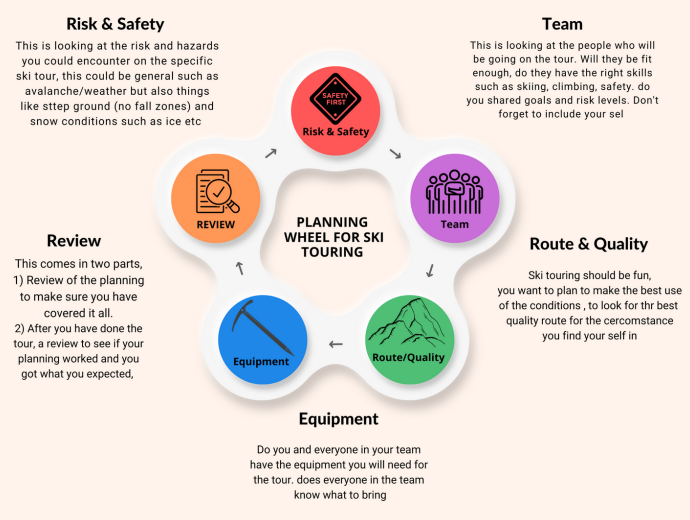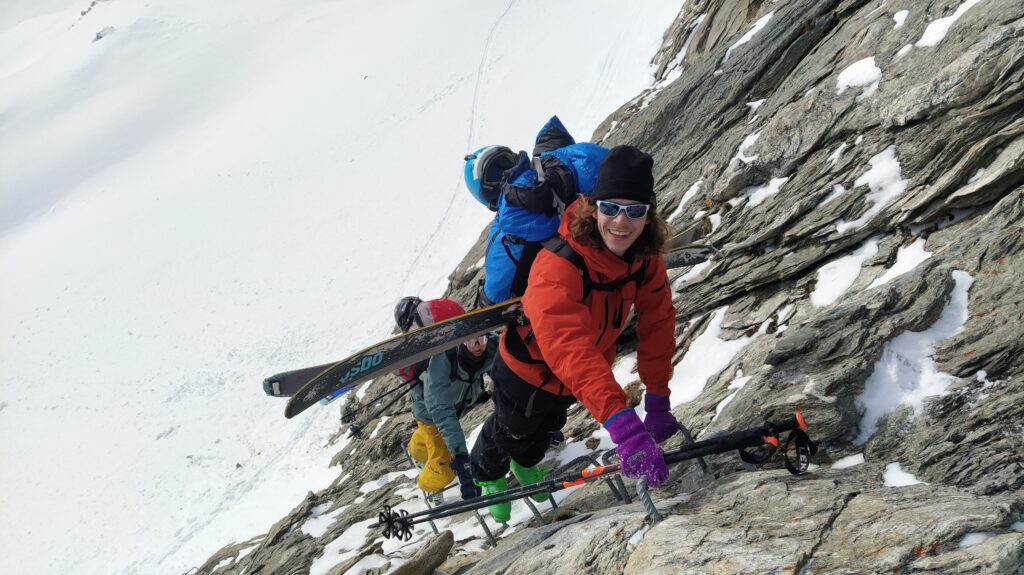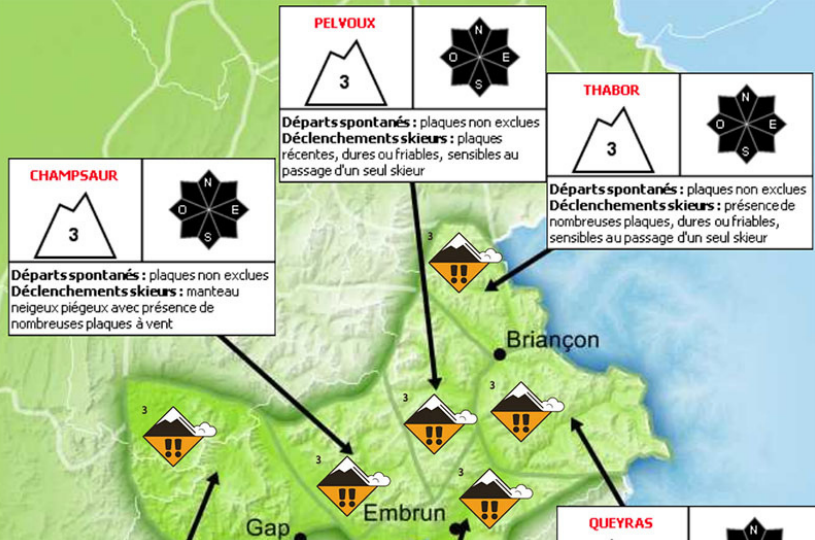PLANNING A SKI TOUR
Part onePlanning a fun, safe ski tour takes time and it’s
a skill that’s worth mastering. It can be
daunting as a beginner and even as a
seasoned ski tourer it can be hard work trying
to find the good stuff every time.
As a ski touring guidebook writer and someone
who loves to ski new areas and lines I spend a
a lot of time planning tours and looking to find
new lines to ski, and I wanted to share how I
structure my planning.
In this two-part article, I will introduce the
planning wheel, explain each element and
give examples of how to plan for each section.


Safety & Risk
At this point I am going to state the obvious, that you need
real avalanche awareness training to be able to plan a safe
route, which is outside the scope of a blog post. But I can
explain where I get my information from to help with the
planning.
Weather forecast – the avalanche forecast is based on the
weather forecast so its good to keep an eye on this, as if this
is wrong it could effect the accuracy of the avalanche
forecast. Also the weather itself can be a hazard. You need to
find a weather forecast that gives the most accurate forecast
possible. Weather forecasts are based on a grid system, so
the whole world is covered by a series of grids and it
forecast you get is based on the grid you area is in. Not all
forecast use the same size grids, often poor forecasts have
really big grids meaning that box can cover a massive area,
therefore it’s not going to be that accurate for a single
mountain at a set altitude. You want to find a forecast that
works on the smallest grid possible – in France I use
meteoblue.com this has the smallest grid’s in France. A top
tip – on meteoblue you can click the crosshairs symbol next
to the search button and it takes you to a map or allows you
to enter a gps reference, where you can select the mountain
or face you want to ski, and it will give you the most
accurate forecast for that place.
Avalanche forecast – A lot of mountainous areas have an
established avalanche forecast, you need to find the one
local to where you will be skiing and make sure you
understand how to interpret it. Don’t just look at the
graphics but read the text to get as much detail as you can,
and this should indicate the less risky areas to ski.
I like to check my local weather forecast and avalanche
report every day even if not skiing, it allows me to build up a
picture of what the snow pack is doing. When the weather
changes you should see changes in the avalanche forecast,
this keep you in touch with what’s happening and what the
snow pack and conditions should be like. If going to a new
area or country I like to do this for a few weeks in advance of
the trip if I can.
Ski Touring Planning wheel
I call it a planning wheel because you can keep going round
collecting more information until you are happy you have the
right plan for the right tour.
Where to start on the wheel? In an ideal world you would start
with the safety as this should be the over arching issue that
governs what and where you ski, this is easier to do if you live
in the mountains or are already on your holiday and planning
the tour for the next day. One issue is if you select a cool
looking line from a guidebook first and then start planning if its
safe to ski, you could fall in to the trap of trying to bend the
conditions to the route you want to do, which isn’t great.
But it’s not always possible to start with the safety or risk level.
You could be planning for your two week holiday in 6 months
time or you already know you want to do something like the
Haute Route. Maybe your starting point is the team as you have
just agreed to go away with people you don’t know that well.
It doesn’t really matter where you start as long as you go round
the wheel at least twice, the reason for twice is each section
will need to be reviewed in relation to the new information. For
example you don’t know if you need a rope until you have
selected the route, but also you can’t select a route that needs a
rope if you don’t have one.

Other options for information – Official forecasts are the
gold standard for information for planning, but there are
some other options for getting info. A lot of these involve
asking others for their opinions which is good, but you
have to bear in mind their experience and how reliable it
will be. I never take one piece of information from below
as golden, but like to get lots of it to help build a picture.
– Talking to guides, ski instructors and ski patrollers.
– Site like skitour.fr and camp to camp that have features
where people log their tours and list snow conditions
and if they have seen avalanche activity.
– In France http://www.data-avalanche.org is a site that
records avalanche and is a great site for information.
– You can also ask on social media, there are Facebook
groups, or locals that are promoting stuff on social
media.
-Bonus source idea: you can always reach out to our ambassadors!
TEAM
This is a huge subject when planning a tour, who are you going with, having a team that have shared goals and mindset to risk etc can make the difference between a great tour and a nightmare tour. You need to ask a few questions in regards to your team. Some of the answers you may already know with regular ski partners, if you don’t it’s definitely worth finding out the answers before you go. Things to consider. Don’t forget to include yourself in
the team.
Fitness – what distance and height gain can every member of the group deal with. Also think about pace in this, someone may like to set off like a racing snake which may not work for everyone.
Health – does any member have health issues that could effect the day. Some people don’t like to share but it’s important to know. I have been ill on a tour and needed the team to support me.
Risk – do you have a shared level of risk that you’re willing to take, you may not want to be out skiing with a team with a very high tolerance to risk.
Technical skills – what level of skiing or even mountaineering skills does the team have. If someone has lower level of technical skills, is the route suitable, is there enough support in the team to help them on a trip that may push them, and is that what they want to do.
Equipment – does everyone have the equipment they need to do the tour, and what standard is it, you maybe on your super light set up but others maybe on very heavy kit which could effect th tour. Or perhaps one member is wearing light clothing wanting to go faster and others are wearing heavy kit and happy to be slower.
Safety – have team members done some form of avalanche awareness course. Do they understand avalanche terrain? Do they know the warning signs they are looking for? Do they have any rescue skills?
Goals and objectives – are some people looking to ski the gnar and others looking for a more chilled day?
A big part of being a team is communication, making sure everyone knows and understands the plan, the goals and objectives and what kit each person is bringing. A great way to do this is a group chat on WhatsApp or Facebook. It’s also handy to have a leader to guide this process, very often a leader will emerge within a group, but if not then it’s worth giving that role to someone.

In conclusion, planning a ski tour can be a hassle-free and enjoyable experience with the right guidance. To make the process even easier, Rob Benton, the writer of this article, has put together a comprehensive booklet with Fatmap. This booklet is packed with all the information and resources you need to plan the perfect ski tour. Whether you’re a seasoned skier or just starting out, this booklet will provide you with the confidence and knowledge to tackle the slopes with ease. So, don’t wait any longer!

